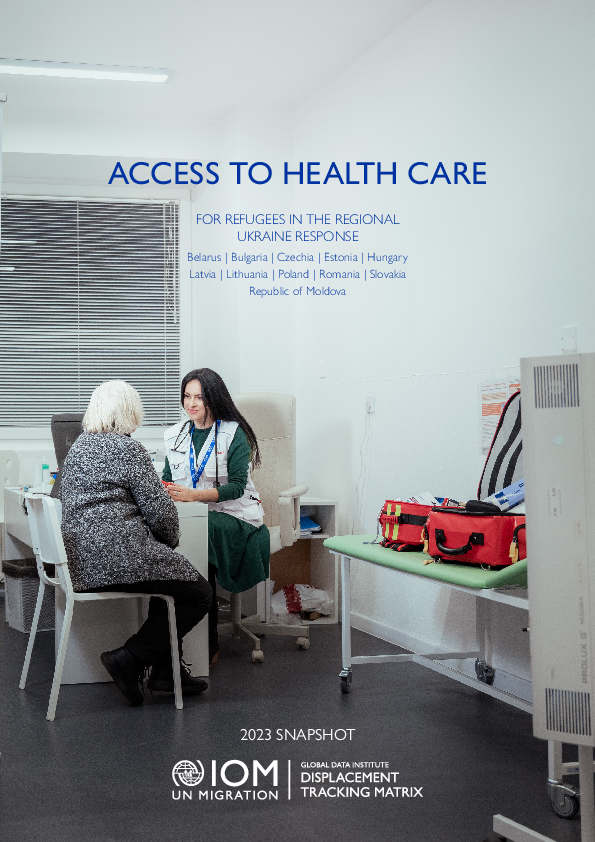-
Countries
-
Data and Analysis
-
Special Focus
-
Crisis Responses
From January to December 2023, IOM’s Displacement Tracking Matrix (DTM) collected data on the Needs, Intentions, and Integration Challenges of refugees from Ukraine and Third-Country Nationals (TCNs) in 11 countries in the Ukraine Response: Belarus, Bulgaria, Czechia, Estonia, Hungary, Latvia, Lithuania, Poland, Republic of Moldova, Romania, and Slovakia. Over the course of 2023, a sample of a total of 28,712 respondents were surveyed on displacement patterns and experiences, including access and barriers to health care.
Key Findings
- One-third (34%) of respondents stayed with at least one person (including themselves) with a chronic condition.
- 16% of respondents had or accompanied someone with at least one disability in 2023.
- Across all 11 countries, 54% of the people interviewed faced one or more challenges to accessing health care.
- Top barriers included long waiting times (30%) and the language barrier (23%).
- Top health needs reported were health-care services (41%), medicines (29%) and psychological counselling (5%).
- 37% of households needed to pay for both health-care services and medicine.
- 42% of respondents needed more information on health-care services, 17% on psychological counselling and 12% on medicine.
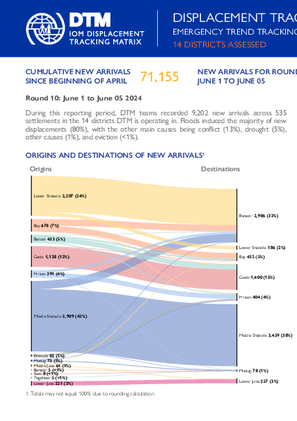
Contact
DTM Somalia, IOMSomaliaDTM@iom.int
Language
English
Location
Somalia
Period Covered
Jun 01 2024
Jun 05 2024
Activity
- Mobility Tracking
- Baseline Assessment
This latest round of Emergency Trends Tracking was initiated in April 2024 to monitor displacements movements during the Gu rainy season. Districts covered in this round include Afgooye, Afmadow, Baardheere, Baidoa, Balcad, Belet Weyne, Dayniile, Gaalkacyo, Hodan, Jamaame, Jowhar, Kahda, Kismaayo, Luuq.
ETT is a crisis-based tool that tracks sudden displacement triggered by specific events or emerging crises. The objective of ETT is to help prioritize humanitarian response and to enable partners to deliver rapid assistance. Based on previous shock induced displacement patterns, the humanitarian community expects that people will continue to move toward urban areas in search of humanitarian services. Consequently, the ETT coverage focuses on the main urban centers and surrounding villages for each assessed district. The data is collected through Key Informant Interviews (KIIs) at the location level, from Sunday to Wednesday every week. It includes information on new arrivals, numbers and demographic of IDPs, reasons for displacement, intentions, humanitarian assistance and priority needs among others.
The ETT tool also adapts to regional contexts: because of the very high number of IDP sites in Khada and Daynile districts in Banadir region and in Baidoa district in Bay region, a zonal approach has been adopted for these areas. Each week, KIIs are first conducted at the zone level to indicate to the field teams which locations have received the most new arrivals and which need to be assessed.
To facilitate the joint analysis of the CCCM (Camp Coordination and Camp Management) Cluster’s New Arrivals Tracker (NAT) and ETT data, the assistance and needs indicators are identical in both tools.
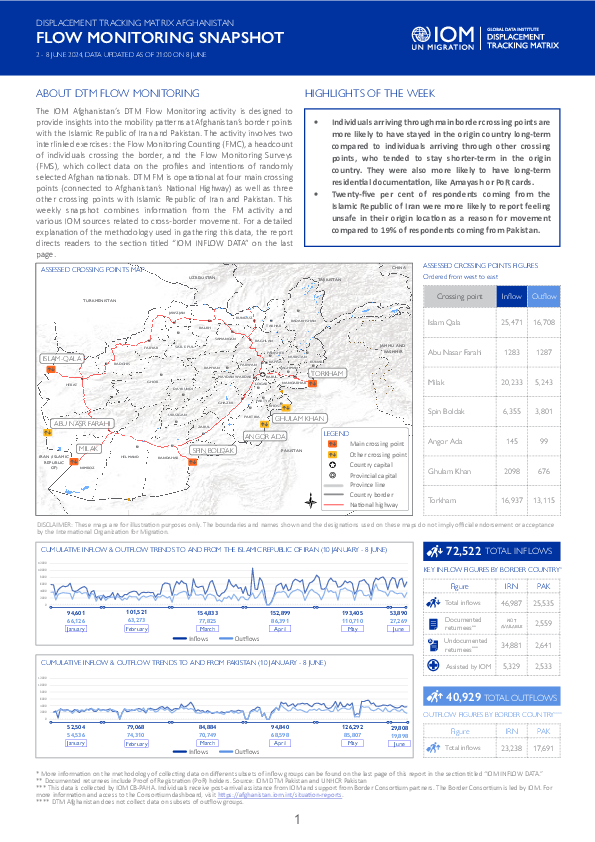
Contact
DTMAfghanistan@iom.int
Language
English
Location
Afghanistan
Period Covered
Jun 02 2024
Jun 08 2024
Activity
- Survey
- Flow Monitoring Survey
- Flow Monitoring
The IOM Afghanistan’s DTM Flow Monitoring activity is designed to provide insights into the mobility patterns at Afghanistan’s border points with the Islamic Republic of Iran and Pakistan. The activity involves two interlinked exercises: the Flow Monitoring Counting (FMC), a headcount of individuals crossing the border, and the Flow Monitoring Surveys (FMS), which collect data on the profiles and intentions of randomly selected Afghan nationals. DTM FM is operational at four main crossing points (connected to Afghanistan’s National Highway) as well as three other crossing points with Islamic Republic of Iran and Pakistan. This weekly snapshot combines information from the FM activity and various IOM sources related to cross-border movement. For a detailed explanation of the methodology used in gathering this data, the report directs readers to the section titled “IOM INFLOW DATA” on the last page.

Contact
IraqDTM@iom.int
Language
English
Location
Iraq
Period Covered
Mar 01 2024
Mar 15 2024
Activity
- Mobility Tracking
- Event Tracking
يقيس تقرير تتبع حالات الطوارئ المناخية هذا (الترجمة العربية) النزوح الناجم عن المناخ في جميع أنحاء وسط وجنوب العراق. العائلات المشمولة في تقارير تتبع حالات الطوارئ هذه هي تلك التي أُجبرت على الانتقال من مواقعها بسبب الجفاف وندرة المياه والتدهور البيئي وعوامل مناخية أخرى.
وحتى 15 مارس/آذار 2024، لا تزال 23,364 عائلة (140,184 فرداً) نازحة بسبب العوامل المناخية في 12 محافظة. وتنتشر الأسر النازحة في 497 موقعًا. من بين هذه الأسر، أقل بقليل من نصف الأسر النازحة داخل منطقتهم الأصلية (47%). أكثر بقليل من نصف الأسر النازحة إلى مواقع حضرية.
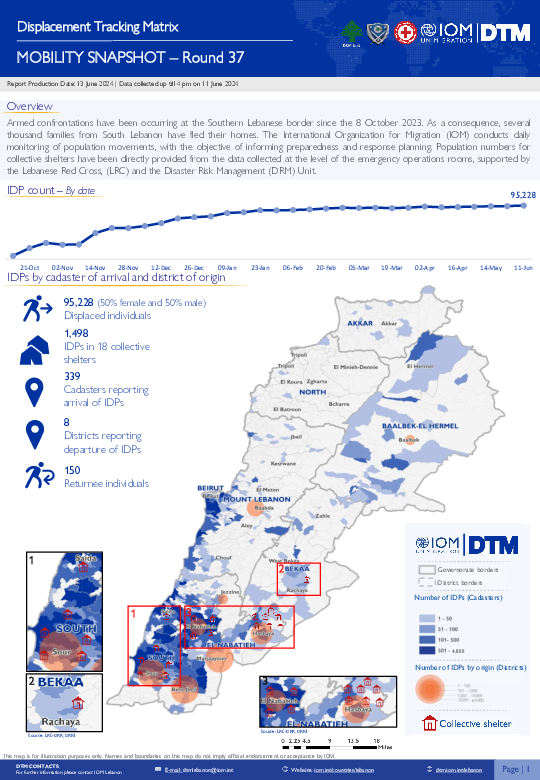
Contact
dtmlebanon@iom.int
Language
English
Location
Lebanon
Period Covered
Oct 10 2023
Jun 11 2024
Activity
- Mobility Tracking
- Baseline Assessment
Since October 8 there has been an increase in cross-border incidents between Israel and Lebanon, resulting in the displacement of people both within the South and elsewhere within the country. Since October 10, the Displacement Tracking Matrix (DTM) has been conducting the daily monitoring of population movements. The objective of the exercise is to inform preparedness and response planning.
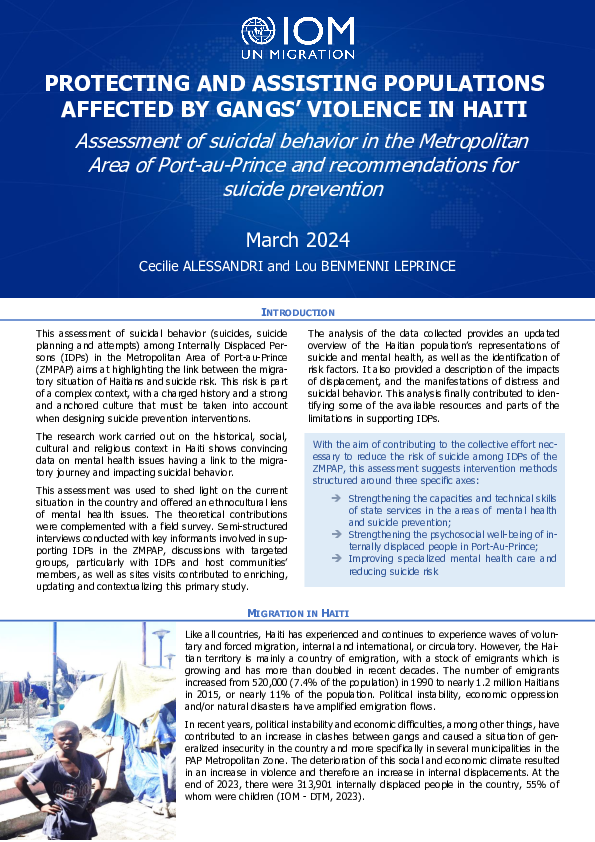
Contact
DTM Haiti, dtmhaiti@iom.int
Language
French
Location
Haiti
Period Covered
Feb 01 2024
Mar 04 2024
Activity
- Other
This assessment of suicidal behavior (suicides, suicide planning and attempts) among Internally Displaced Per-sons (IDPs) in the Metropolitan Area of Port-au-Prince (ZMPAP) aims at highlighting the link between the migratory situation of Haitians and suicide risk. This risk is part of a complex context, with a charged history and a strong and anchored culture that must be taken into account when designing suicide prevention interventions.
With the aim of contributing to the collective effort necessary to reduce the risk of suicide among IDPs of the ZMPAP, this assessment suggests intervention methods structured around three specific axes:
➔ Strengthening the capacities and technical skills of state services in the areas of mental health and suicide prevention;
➔ Strengthening the psychosocial well-being of internally displaced people in Port-Au-Prince;
➔ Improving specialized mental health care and reducing suicide risk

Contact
DTM Ethiopia, DTMEthiopia@iom.int
Language
English
Location
Ethiopia
Period Covered
Jul 01 2019
Jan 08 2023
Activity
- Mobility Tracking
- Site Assessment
- Village Assessment
The objective of this thematic report is to provide an overview of the International Organization for Migration (IOM)'s Data and Research Unit (DRU) data collected through its Displacement Tracking Matrix (DTM) methodology and Site Assessment (SA) and Village Assessment Survey (VAS) tools deployed at the location level in Ethiopia between July 2019 and January 2023. Through the SA, sites hosting at least 20 IDP households are assessed and, through the VAS, villages hosting at least 20 returning IDP households are assessed.
This overview gathers and analyzes specific data records on displacement and returns related to drought and other climate-induced factors such as floods, landslides and fires.
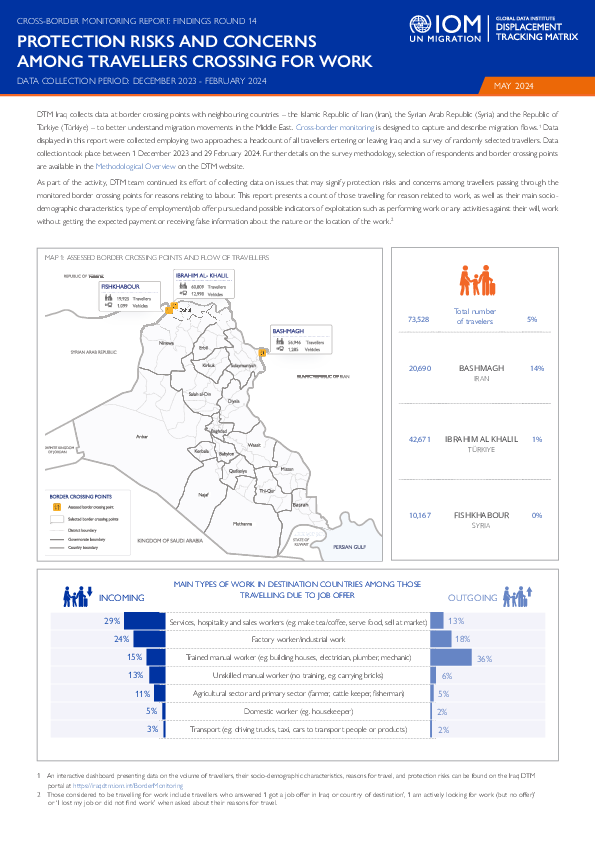
Contact
DTM Iraq, IraqDTM@iom.int
Language
English
Location
Iraq
Period Covered
Dec 01 2023
Feb 29 2024
Activity
- Survey
- Flow Monitoring Survey
- Flow Monitoring
The Cross-Border Monitoring Report: Protection Risks and Concerns Among Travellers Crossing for Work data on labour-related protection risks among travellers passing through border crossing points monitored by IOM.
The main types of employment for incoming travellers were services, hospitality, and sales (29%); along with factory work (24%); Trained manual worker (15%) and unskilled manual labour (13%). For outgoing travellers, the main types of work were trained manual labour (36%); factory work (18%); Services, hospitality and sales workers (13%) and unskilled manual labour (6%).
The top protection concerns faced by these travellers were the provision of false information by employers regarding the nature of the work and working without receiving the expected payment.
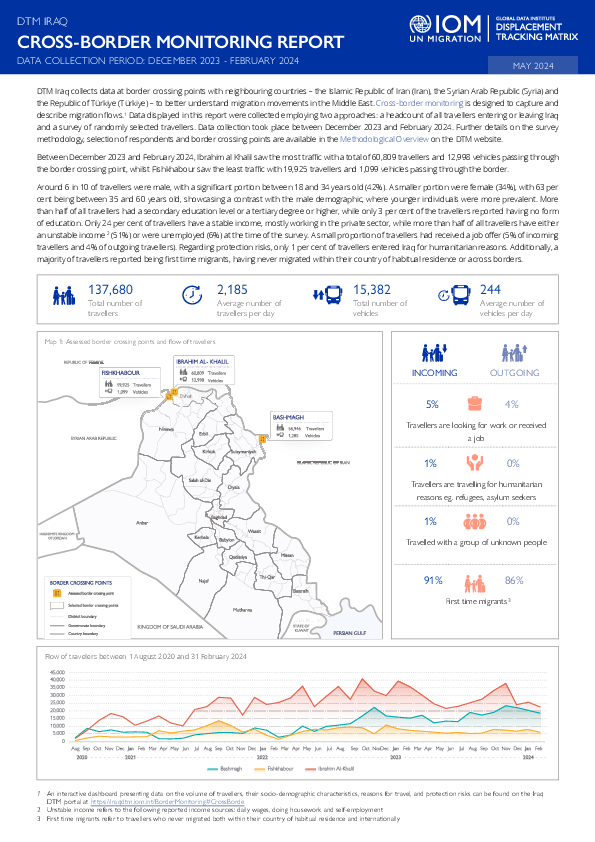
Contact
IraqDTM@iom.int
Language
English
Location
Iraq
Period Covered
Dec 01 2023
Feb 29 2024
Activity
- Survey
- Flow Monitoring
The Cross-Border Monitoring Report presents data collected at border crossing points with neighbouring countries – the Islamic Republic of Iran, the Syrian Arab Republic and Türkiye – to better understand migration movements in the Middle East. The report and dashboard provide an overview of travellers’ movements, their main socio-demographic characteristics, employment status, countries of origin, countries of destination and main reasons for travel.
Between December 2023 and February 2024, Ibrahim al Khalil saw the most traffic with a total of 60,809 travellers and 12,998 vehicles passing through the border crossing point, whilst Fishkhabour saw the least traffic with 19,925 travellers and 1,099 vehicles passing through the border.
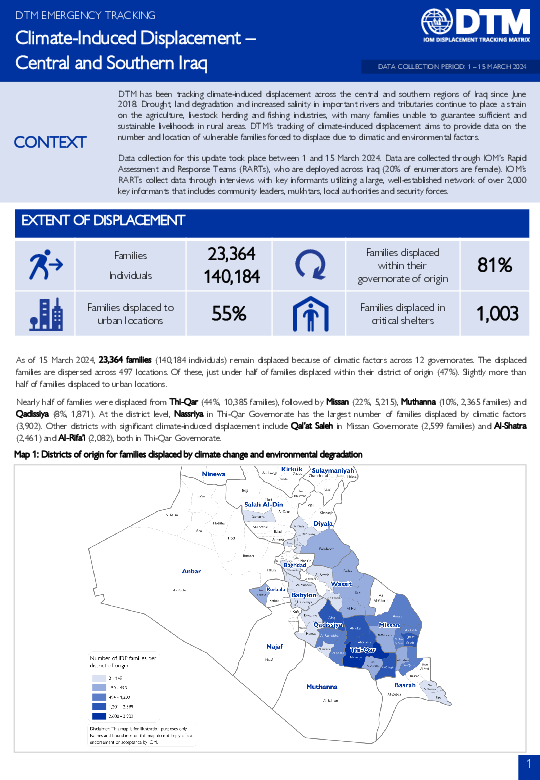
Contact
IraqDTM@iom.int
Language
English
Location
Iraq
Period Covered
Mar 01 2024
Mar 15 2024
Activity
- Mobility Tracking
- Event Tracking
This Climate Emergency Tracking Report measures climate-induced displacement across central and southern Iraq. Families included in these Emergency Tracking reports are those forced to move locations due to drought, water scarcity, environmental degradation and other climatic factors.
As of 15 March 2024, 23,364 families (140,184 individuals) remain displaced because of climatic factors across 12 governorates. The displaced families are dispersed across 497 locations. Of these, just under half of families displaced within their district of origin (47%). Slightly more than half of families displaced to urban locations.
